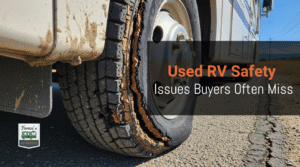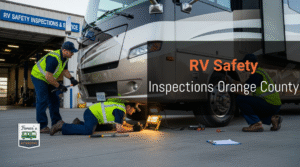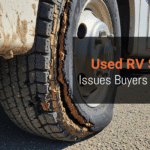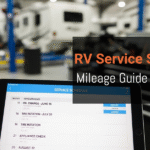Understanding weight distribution systems is essential for anyone towing a trailer, especially when safety and vehicle control are priorities. These systems help evenly spread the trailer’s weight across the towing vehicle’s axles, reducing sway and improving handling on the road. Proper use of a weight distribution system enhances stability, minimizes wear on your vehicle, and creates a safer towing experience.
Farace Automotive & R.V. Center in Huntington Beach, California, specializes in trailer repairs and installations, including weight distribution hitches. With over 40 years of experience, they help ensure trailers are balanced correctly to prevent common towing problems like swaying and poor braking performance.
For trailer owners looking to improve their towing safety and vehicle control, understanding how weight distribution systems work is the first step. This article will explain key concepts and practical tips to help drivers achieve better stability and protection for both their vehicles and cargo.
What Is a Weight Distribution System and How It Works
A weight distribution system helps evenly spread the trailer’s load across the towing vehicle and trailer axles. This improves stability, braking, and handling when towing heavy trailers.
Basic Mechanics Behind Weight Distribution
Weight distribution systems use leverage to transfer some trailer tongue weight from the rear of the towing vehicle to the front axle and trailer axles. This prevents the rear of the vehicle from sagging and the front tires from lifting, maintaining better steering control.
The system typically employs spring bars, which attach to the trailer frame and the hitch. These bars apply upward force on the trailer and downward force on the vehicle’s front axle. This balance reduces uneven weight transfer and distributes load more effectively.
Differences Between Standard Hitches and Weight Distribution Hitches
Standard hitches only connect the trailer to the towing vehicle without addressing weight distribution. They allow the trailer’s tongue weight to rest on the rear of the vehicle, often causing sagging and poor steering response.
Weight distribution hitches, in contrast, include spring bars and brackets to redirect the load. This setup improves towing safety, reduces trailer sway, and enhances braking performance by balancing the load across both axles.
Role of Spring Bars and Sway Control
Spring bars are crucial components that provide the leverage needed to distribute weight evenly. They attach to the hitch head and trailer frame and flex under load to balance weight between axles.
Many weight distribution systems integrate sway control, which limits side-to-side trailer movement. This increases stability on windy roads or during sudden maneuvers by reducing trailer sway and improving overall towing control.
Why Weight Distribution Matters for Safe Towing
Proper weight distribution affects how a trailer behaves on the road in critical ways. It directly influences stability, vehicle handling, and braking efficiency. These factors combined lead to a safer towing experience and better control.
Reducing Sway and Improving Steering Control
Uneven weight on the trailer tongue can cause trailer sway, which makes steering unpredictable and dangerous. A weight distribution system shifts part of the load from the rear of the tow vehicle to its front axle. This balance reduces sway by stabilizing the trailer and limiting side-to-side movement.
Improved weight balance also means the tow vehicle’s tires maintain better road contact. This results in more responsive steering and greater driver confidence, especially at higher speeds or in windy conditions. Properly distributed weight reduces the risk of loss of control and accidents caused by trailer instability.
Protecting Your Tow Vehicle’s Suspension
Trailers that put too much weight on the tow vehicle’s rear can overload the rear suspension. This causes sagging, uneven tire wear, and potential damage to suspension components. A weight distribution system transfers some load forward, which evenly spreads the mass across both axles.
This balance helps prevent premature suspension failure and preserves vehicle handling characteristics. It reduces the strain on springs, shock absorbers, and other parts. By shielding the suspension, weight distribution saves on costly repairs and helps maintain consistent vehicle performance during towing.
Enhancing Braking and Stopping Power
Correct weight distribution ensures that braking forces are applied more evenly between the tow vehicle and trailer. If too much weight rests on the rear axle, braking efficiency decreases because the front tires may lose traction. This can lead to longer stopping distances.
With a balanced load, the tow vehicle’s front and rear brakes engage effectively. Trailers with weight distribution systems also perform better with trailer brake controllers, which improve stopping power. This combination shortens stopping distances and reduces the risk of jackknifing or loss of control during sudden braking situations.
Signs You Need a Weight Distribution System
Imbalanced trailer weight can cause several noticeable issues that affect towing safety and vehicle performance. These include changes in trailer shape when hitched, handling problems at higher speeds, and signs of wear on tires and fuel efficiency.
Trailer Sag or “V” Shape When Hitched
When a trailer is hitched without proper weight distribution, the rear of the tow vehicle may sag while the trailer tongue drops. This creates a distinct “V” shape between the vehicle and trailer.
This sagging shifts weight unevenly, concentrating too much load on the rear axle of the tow vehicle. It reduces front-wheel contact with the road, impacting steering control and braking performance.
A weight distribution system helps level the connection by transferring tongue weight across the tow vehicle’s axles evenly. This prevents the visible sag and ensures the rig remains properly balanced.
Poor Handling or Sway at Highway Speeds
Improperly distributed tongue weight often causes trailer sway during highway driving. The rear-heavy setup allows the trailer to push and pull the tow vehicle, especially in crosswinds or when passing large vehicles.
Drivers may experience unstable steering, excessive body roll, or sudden side-to-side trailer movement. This decreases overall control and increases the risk of accidents.
Installing a weight distribution system improves handling by stabilizing the trailer and keeping the towing rig aligned. It distributes weight more evenly front to back and side to side, reducing sway and improving highway stability.
Uneven Tire Wear and Reduced MPG
Uneven weight on the axles leads to irregular tire wear on the tow vehicle and trailer. The rear tires may wear faster due to extra load, while front tires lose grip from underloading.
Excess weight on the rear also affects suspension and increases rolling resistance. This causes the engine to work harder, lowering fuel efficiency over time.
A weight distribution system balances load across all axles, helping tires wear evenly and reducing strain on the vehicle. This balance supports better fuel economy and extends the life of tires and suspension components.
Types of Weight Distribution Systems
Weight distribution systems vary primarily in their bar design and sway control features. Choosing the right type depends on trailer weight, towing stability needs, and ease of adjustment. Understanding these differences will help in selecting a system tailored to specific towing setups.
Round Bar vs. Trunnion Bar Systems
Round bar systems use curved steel bars that extend from the hitch head to spring bars, offering a simpler installation and wide availability. They tend to be more affordable and are ideal for lighter to medium-weight trailers.
Trunnion bar systems feature straight bars set in pivoting brackets, allowing for stronger leverage and greater load capacity. This design typically supports heavier trailers and provides a more durable solution for frequent or long-distance towing.
Both options distribute tongue weight across the tow vehicle and trailer axles but differ in weight capacity, adjustment options, and smoothness of tow.
Integrated Sway Control vs. Add-On Sway Bars
Integrated sway control is built into some weight distribution hitches, activating automatically to reduce trailer sway without extra parts. This system offers seamless connection and reduces complexity in setup.
Add-on sway bars attach separately to a standard weight distribution hitch. They provide customizable sway resistance but require additional installation and maintenance.
Integrated sway control suits those preferring a cleaner setup and less manual adjustment. Add-on sway bars work well for users who need flexible sway management for varying trailer and road conditions.
Which Type Works Best for Different Trailer Setups
For trailers under 7,000 pounds, round bar weight distribution systems with add-on sway bars often provide sufficient stabilization and control. They balance cost and performance for moderate towing demands.
Heavy-duty trailers over 7,000 pounds generally benefit from trunnion bar systems, due to their enhanced capacity and rigid structure. Integrated sway control on these systems helps maintain stability on longer hauls.
Single-axle trailers may not always require weight distribution but benefit from basic sway control. Dual-axle trailers with significant tongue weight see improved handling and safety with properly matched systems.
How to Choose the Right Weight Distribution Hitch
Selecting the proper weight distribution hitch requires precise consideration of the trailer’s tongue weight, the overall trailer and vehicle weight ratings, and the compatibility with the tow vehicle and its hitch receiver. Each factor directly impacts towing stability, safety, and vehicle control.
Matching the Hitch to Your Trailer’s Tongue Weight
The tongue weight is the downward force the trailer places on the hitch ball. Choosing a weight distribution hitch that matches this weight is critical for balanced towing.
Hitches come rated for specific tongue weight capacities. For example, if the trailer’s tongue weight is 800 pounds, the hitch should support at least that weight to evenly spread this load across the vehicle and trailer axles.
Undersized hitches can cause poor balance, sway, and unsafe handling. Oversized hitches may lead to unnecessary complexity and cost but do not harm towing performance.
Understanding Gross Trailer Weight (GTW) and Gross Vehicle Weight Rating (GVWR)
The Gross Trailer Weight (GTW) is the total weight of the loaded trailer. The Gross Vehicle Weight Rating (GVWR) is the maximum weight the tow vehicle can safely carry, including passengers and cargo.
A weight distribution hitch must suit the GTW to ensure even weight distribution and stable braking. It should also correspond with the tow vehicle’s GVWR so the entire setup remains within safe limits.
Keeping the trailer weight significantly below the GVWR—generally 750 to 1,500 pounds less—is advisable for the best control and safety.
Compatibility with Tow Vehicle and Hitch Receiver
Weight distribution hitches must fit both the tow vehicle and its hitch receiver precisely. Tow vehicles have different hitch classes, such as Class III or Class IV, which determine size and towing capacity.
The hitch receiver size, typically 2 inches for travel trailers, needs to match the weight distribution hitch’s shank.
Selecting a hitch incompatible with the vehicle’s receiver size or weight capacity can compromise towing safety. Ensuring the hitch aligns with both the receiver and vehicle towing limits enhances performance and reduces sway risk.
Installation and Adjustment Tips
Successful installation and adjustment require the right tools, precise alignment, and periodic maintenance. Proper setup ensures the system effectively distributes weight and minimizes trailer sway.
Tools Required and Setup Overview
Essential tools include a torque wrench, socket set, and adjustable wrenches. A tongue weight scale is also necessary to measure and confirm proper tongue weight after installation.
Initial setup begins with securing the hitch head and spring bars to the trailer frame according to manufacturer specifications. The system must match the trailer’s tongue weight and gross trailer weight to avoid overload.
It is important to follow instructions for mounting the hitch shank firmly to the tow vehicle’s receiver. Safety chains and hitch pins should be tight but not overly restrictive to allow for slight movement during towing.
Proper Head Angle and Spring Bar Tension
The hitch head angle affects how weight is transferred from the trailer to the tow vehicle. It should be adjusted so the hitch sits level when the trailer is fully loaded.
Spring bar tension must be set to provide adequate leverage without exceeding the rated tongue weight. Over-tensioning can cause premature wear or damage, while under-tensioning decreases sway control effectiveness.
Adjustment often requires incremental changes and testing by driving short distances to feel the handling response. The goal is to create firm but smooth trailer-to-vehicle connection.
Importance of Re-Torquing and Routine Adjustments
Re-torquing bolts after initial drives is critical, as components may settle under load. Failure to do so can loosen hardware and reduce system reliability.
Routine checks before every trip prevent loose parts and maintain proper tension. Vibrations, temperature changes, and payload shifts necessitate periodic adjustments.
Consistent maintenance improves safety and prolongs component life. Documenting torque settings and adjustments helps track changes over time.
Why Professional Installation at Farace Automotive Makes a Difference
Farace Automotive & R.V. Center employs certified technicians with specialized knowledge in weight distribution systems and the specific needs of Huntington Beach trailers.
They ensure precise fitment and calibration using professional-grade equipment, reducing guesswork and installation errors common in DIY setups.
Technicians also inspect the entire towing assembly, offering tailored recommendations for optimal safety and performance. This service helps prevent costly damage and trailer sway incidents.
Maintenance and Safety Checks
Proper upkeep and routine inspections are essential for trailer weight distribution systems. Regular attention ensures components function correctly and prevents failures that could compromise safety or towing performance.
Inspecting Bars, Chains, and Hitch Components
Weight distribution bars and chains must be checked for cracks, bends, rust, or wear before every trip. Any deformation weakens the system and may cause imbalance.
The hitch should be inspected closely. Ensure the locking mechanisms engage fully and there is no excessive play. Loose or damaged parts can lead to accidental detachment.
Chains must have proper tension and show no signs of fraying. Tighten or replace any components showing damage to maintain secure connections.
Lubrication and Storage Practices
Weight distribution components require regular lubrication to reduce friction and prevent rust. Use a high-quality, corrosion-resistant grease on bars, spring arms, and pivot points.
After use, clean any dirt or debris from the system. Store the bars and chains in a dry, sheltered place to avoid exposure to moisture that accelerates corrosion.
Regular lubrication cycles depend on frequency of use and environment but generally should occur every few months or after heavy exposure to rain or salt.
Pre-Trip Checklist for Safe Towing
Before each trip, verify that weight distribution components are in place and securely fastened. Check that bars and chains are properly aligned and adjusted per the manufacturer’s guidelines.
Confirm the hitch is locked and safety chains crossed under the trailer tongue for backup security. Inspect the trailer’s tires for proper inflation and load rating.
Test the entire towing connection by applying gentle pressure to ensure there is no unusual movement. Address any signs of shifting, unusual noises, or instability immediately.
Why Choose Farace Automotive & R.V. Center for Trailer Setup
Farace Automotive & R.V. Center offers specialized expertise in trailer hitch systems and weight distribution tailored to the unique demands of Southern California drivers. Their service balances technical precision with personalized solutions to ensure safe and efficient towing. Customers can expect reliable service backed by decades of experience and a commitment to quality.
Over 40 Years Serving Southern California Trailer Owners
Since 1976, Farace Automotive & R.V. Center has been a trusted resource for RV and trailer owners in Huntington Beach and the surrounding area. This extensive experience means they understand the local terrain, climate factors, and common towing challenges faced by their clients.
Their long-standing presence reflects a deep knowledge of various trailer types and setups. This longevity also signals consistent quality in repairs, installations, and inspections of weight distribution systems. Customers benefit from a proven track record and a history of adapting to evolving trailer technologies.
Customized Hitch Solutions Based on Your Needs
Farace Automotive & R.V. Center focuses on tailoring hitch and weight distribution setups to the specific needs of each vehicle and trailer combination. They evaluate factors like trailer weight, tongue weight, and towing frequency to recommend the best system type.
Options range from traditional spring bars to more advanced, adjustable setups designed for precise load balancing. This customization improves vehicle handling, braking efficiency, and tire wear.
They also ensure compatibility with the vehicle’s make and model, avoiding generic one-size-fits-all solutions. This approach provides safer towing and a more comfortable driving experience.
Trusted, Veteran-Family-Owned Local Service
Being a veteran-family-owned business adds a layer of trustworthiness and community connection to their services. Farace Automotive & R.V. Center prioritizes integrity and transparency in all interactions.
Customers often note the respectful, knowledgeable, and personable nature of the staff. This local ownership means they are dedicated to supporting their community with consistent, dependable service rather than scaled, impersonal volume.
The family-operated model encourages attention to detail and accountability in every trailer setup or repair job they undertake.
Customer-First Approach with Safety as a Priority
Safety is central to every weight distribution and hitch service at Farace Automotive & R.V. Center. Their technicians rigorously inspect equipment and verify proper installation to prevent sway, uneven load distribution, and vehicle control issues.
They educate customers about correct hitch adjustments and encourage ongoing maintenance checks. This proactive approach reduces the risk of accidents associated with improper trailer setups.
The focus on safety also extends to using quality parts and adhering strictly to industry standards. This ensures long-term reliability and peace of mind for trailer owners.









